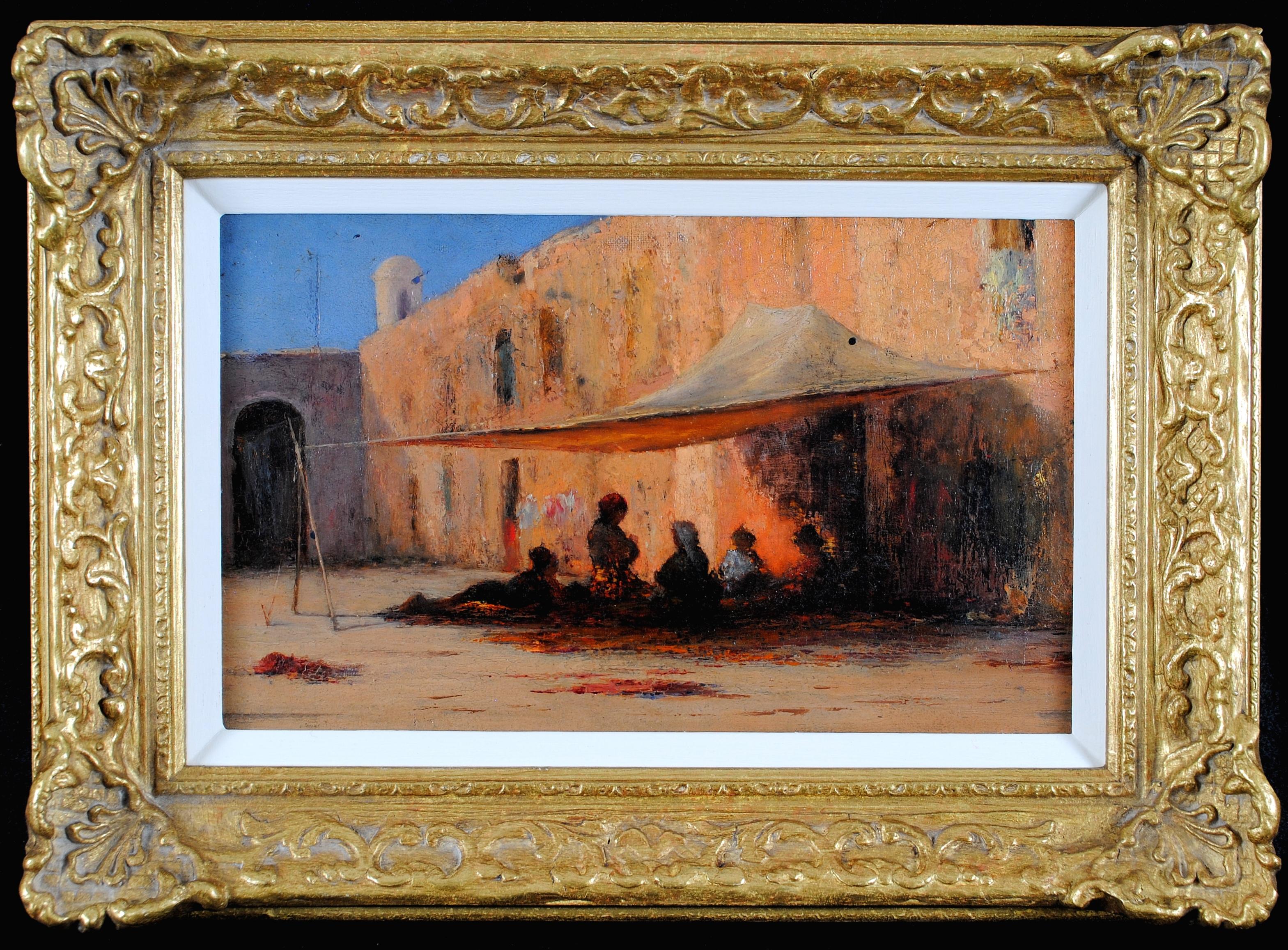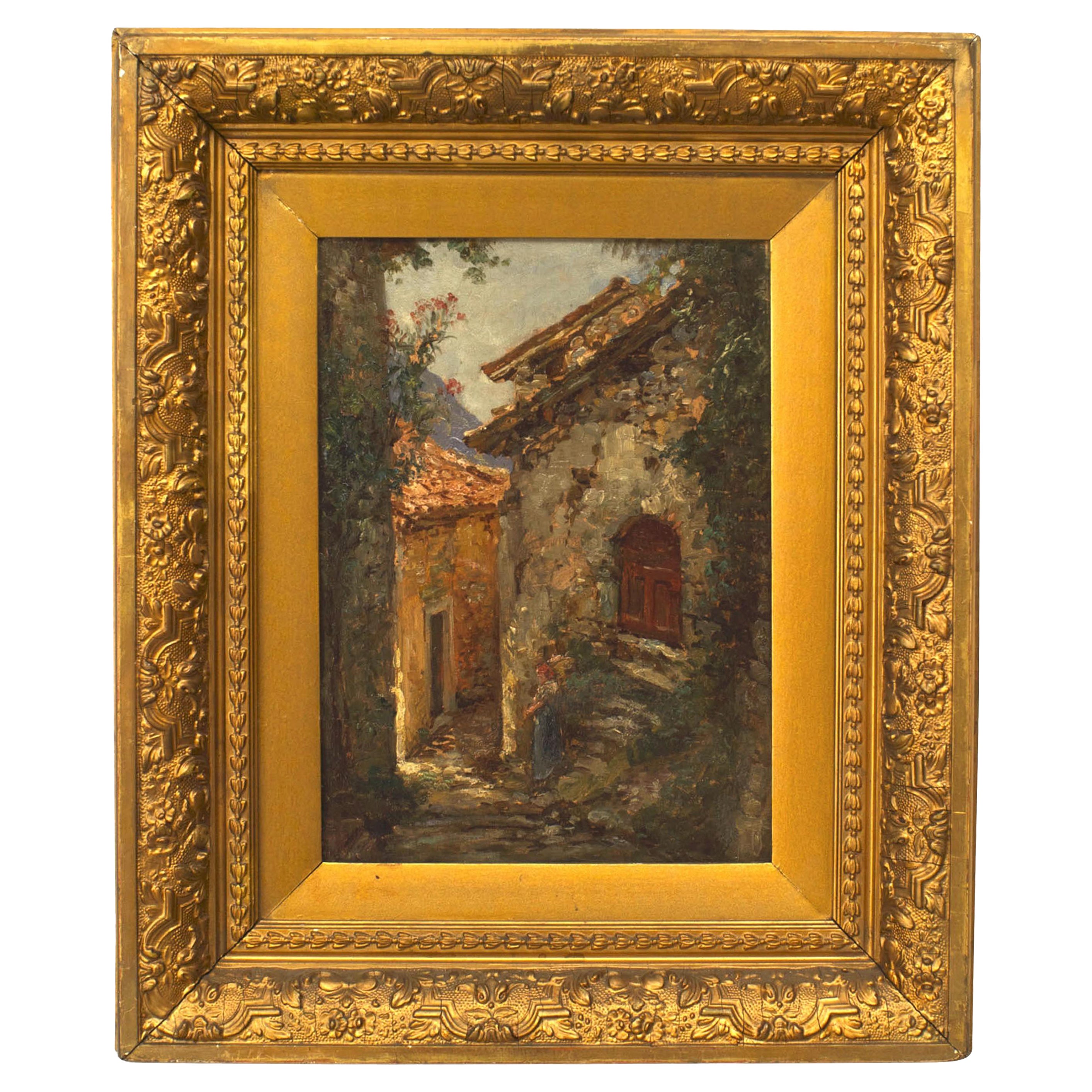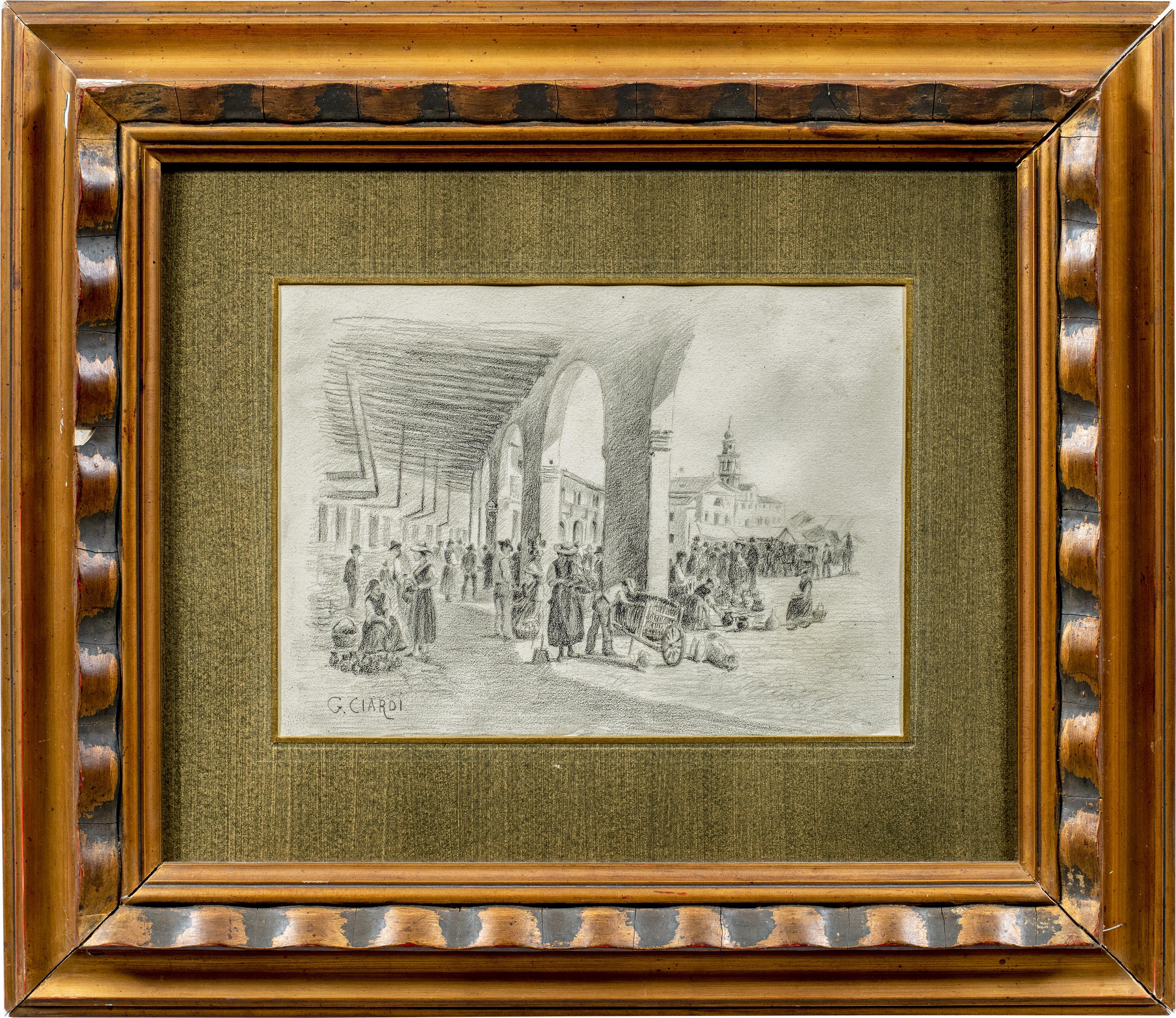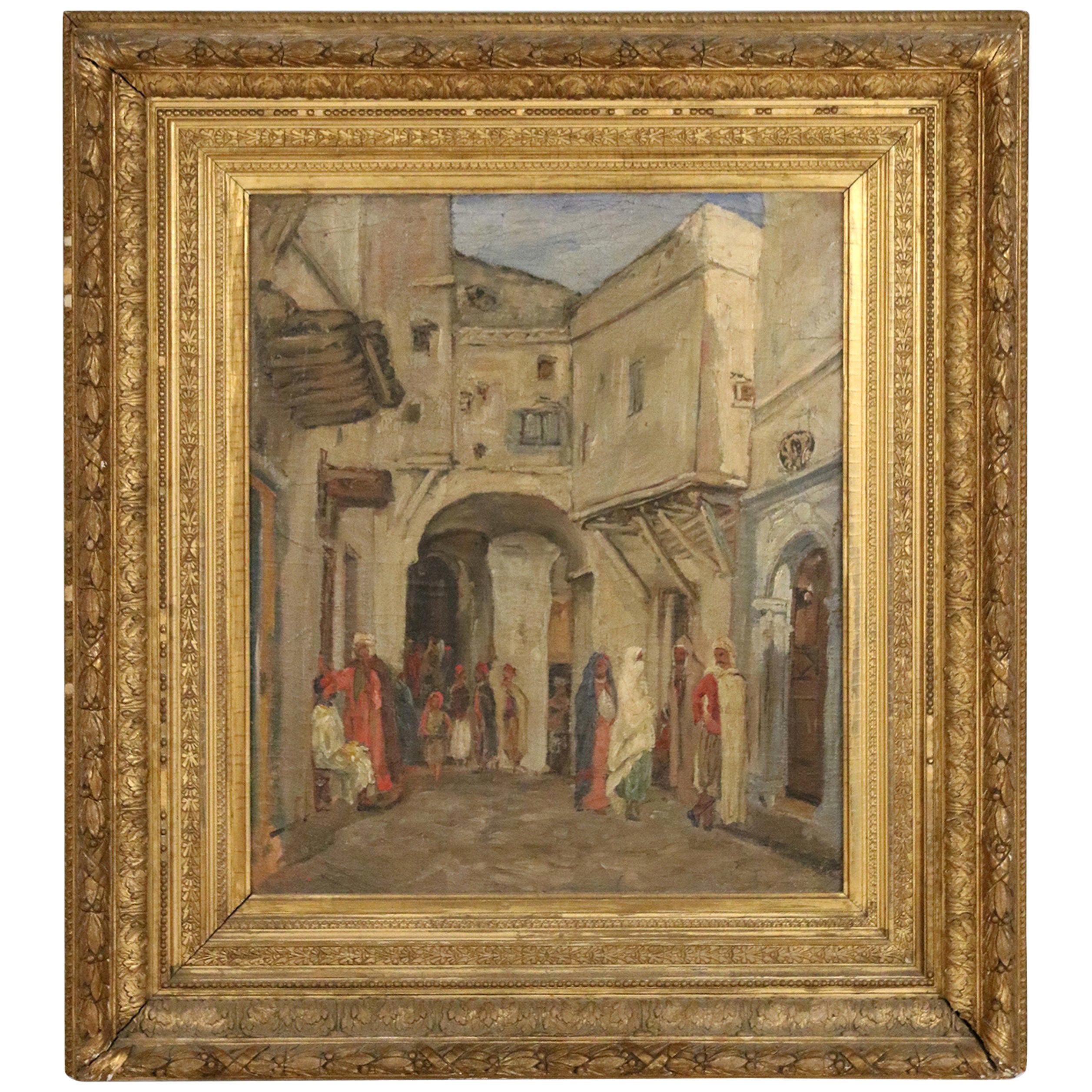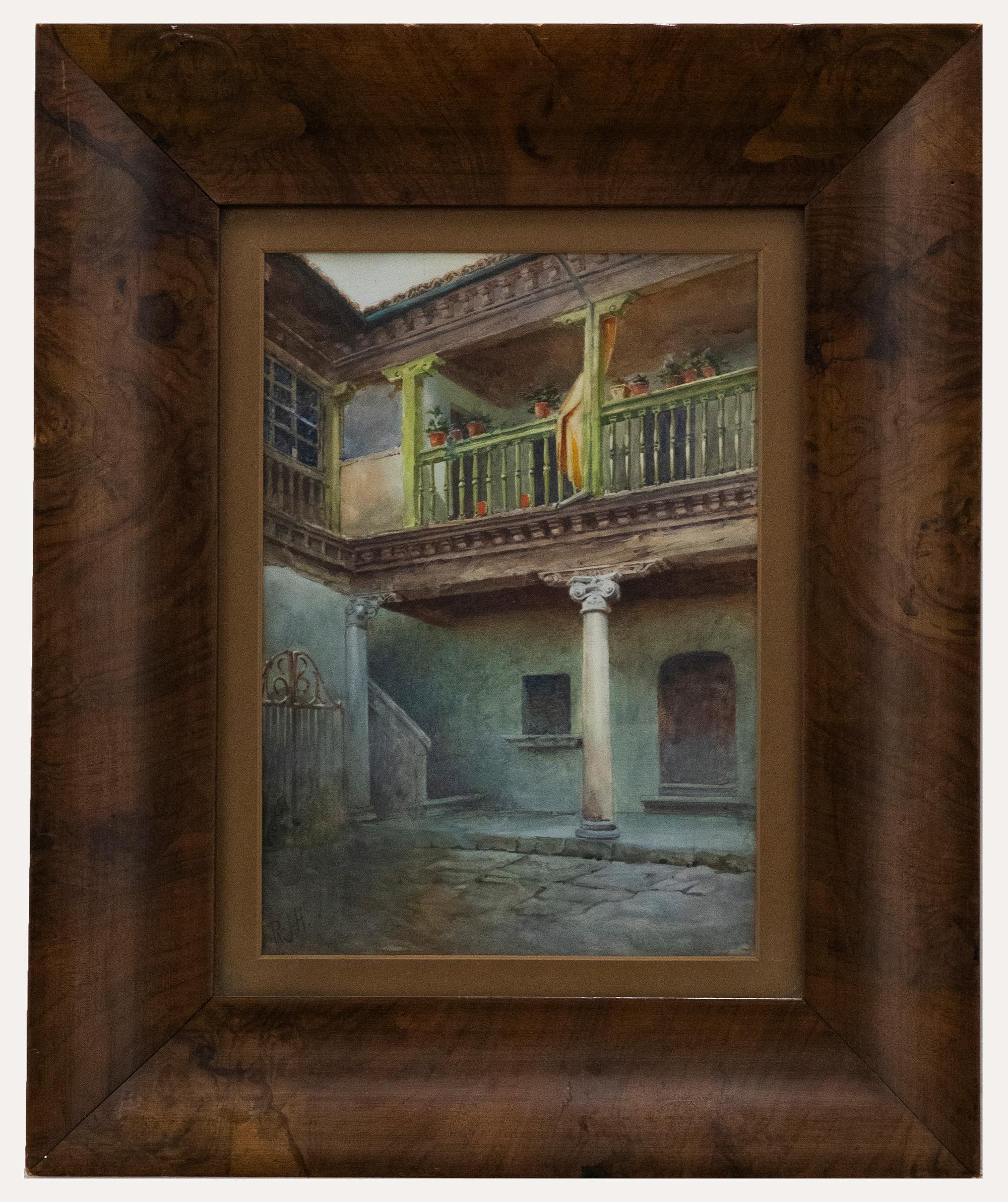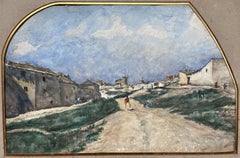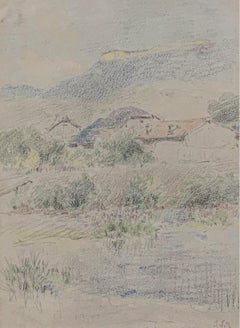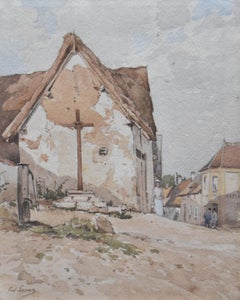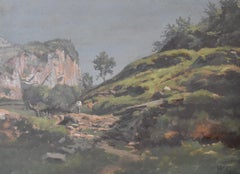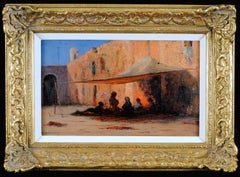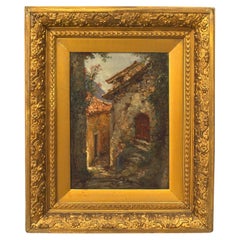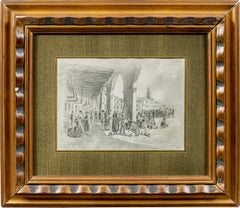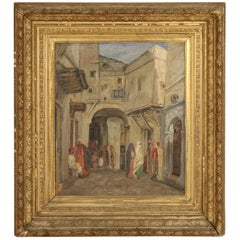Items Similar to J J A Lecomte du Nouÿ (1842-1923) An oriental street, oil sketch
Video Loading
Want more images or videos?
Request additional images or videos from the seller
1 of 10
Jean-Jules-Antoine Lecomte du NouÿJ J A Lecomte du Nouÿ (1842-1923) An oriental street, oil sketch
$1,057.04
£792.05
€895
CA$1,484.19
A$1,626.63
CHF 849.46
MX$19,517.70
NOK 10,666.39
SEK 10,047.35
DKK 6,817.03
About the Item
Jean-Jules-Antoine Lecomte du Nouÿ (1842-1923)
An oriental street
oil on canvas
11.5 x 14 cm
no signature
In good condition, canvas without stretcher, simply framed under glass.
In a modern frame : 22 x 26. 5 cm
Provenance:
as indicated on the reverse, Galerie Emeric Hahn, Paris
Private collection, England
An other fine example of oil sketch, for which Lecomte du Nouÿ is reknown and appreciated. But also as we could see it in an other oil sketch of back and shoulder, a fragmental study.
The artist uses the same framing process to paint a fragment that suggests a composition. He leaves it to the imagination of the viewer of his work to complete this fragment. It is in this sense that Lecomte du Nouÿ was a very innovative and surprising artist.
Jean-Jules-Antoine Lecomte du Nouÿ was born on 10 June 1842 in Paris.
Originally of a Piedmontese origin, his family had been settled in France since the fourteenth century and by the time of his birth had reached the status of nobility
He was an Orientalist French painter and sculptor.
He was strongly influenced by the works and teachings of Charles Gleyre and Jean-Léon Gérôme. Lecomte du Nouÿ found inspiration for his art through extensive travels to Greece, Turkey, Egypt, Romania and Italy.
The thematic content of Lecomte du Nouÿ's work was mainly figural, but also spanned over a vast range of imagery throughout his career, including classical, historical and religious.
Lecomte du Nouÿ is known for remaining faithful to his detailed, realistic style throughout the extent of his career, despite the onset of the Impressionist, Fauvist and Constructivist artistic movements during his lifetime. His work is said to have contributed significantly to the establishment of an iconic repertoire representing the Orient in the nineteenth century.A Parisian street was named after him in 1932.
Lecomte du Nouÿ showed a strong attachment to visual art from a young age and was reported to have painted portraits of his father and uncle by the age of 6.
In 1861, at 19 years of age, the artistic talents of young Jean-Jules-Antoine Lecomte du Nouÿ prompted him to become a pupil at the atelier of Swiss artist, Charles Gleyre. Under Gleyre's guidance Jean-Jules-Antoine learned the significance of individualistic style and gained the foundations of creative visual presentation.
Later, Lecomte du Nouy further perfected his knowledge of the artistic form under the mentorship of Jean-Léon Gérôme, who was a renowned painter of the Academicism movement. It was at this time that Jean-Jules-Antoine learned the precision required to depict "la belle nature" —a style of illustration that aims to create the most beautiful representations of the natural form. This later became one of the main techniques employed in Lecomte du Nouÿ's signature artwork.
In 1865, Du Nouÿ accompanied fellow artist, Félix Auguste Clément, on his travels to Cairo, Egypt. It was after this voyage that the young Lecompte du Nouy sought to portray the opulence of the Orient. In later years, he continued his travels, visiting countries like Italy and Greece. Lecompte du Nouy found inspiration in all social, historical and literary facets of foreign culture.
The Orientalist style is largely characterized by its content, but also by its subdued realism and precision allotted towards depicting the human form. The latter is a prominent characteristic of the 19th century methods upheld by the Académie des Beaux-Arts. Du Nouÿ was a prominent figure within the sphere of academic art and thereby adhered to a rule-based artistic style of well-developed skill and formal composition. The artistic composition of his paintings was often complemented by the use of half-light, which added certain dramatic and melancholic qualities to his work. To this day some, like Alan Braddock, consider Du Nouÿ to have been decidedly modern for his time, because his work directly and indirectly broached some of the key issues of his day, albeit from a decidedly conservative perspective: colonialism, international trade, gender, religion, and history. Du Nouÿ spent most of the later years of his life in Romania. There he painted primarily the royal family and their subjects.However, he returned to Paris right before his death on 19 February 1923.
Artworks by Lecomyte du Nouy are held by museums such as Cleveland Museum of Art, Dahesh Museum of Art in New York, Worcester Art Museum, Musée d'Orsay in Paris, Musée des Beaux-Arts de Nantes, etc....
- Creator:Jean-Jules-Antoine Lecomte du Nouÿ (1842 - 1923, French)
- Dimensions:Height: 4.53 in (11.5 cm)Width: 5.52 in (14 cm)
- Medium:
- Movement & Style:
- Period:
- Condition:
- Gallery Location:Paris, FR
- Reference Number:Seller: Inv 4651stDibs: LU111229877292
Jean-Jules-Antoine Lecomte du Nouÿ
Jean-Jules-Antoine Lecomte du Nouÿ was born on 10 June 1842 in Paris. Originally of a Piedmontese origin, his family had been settled in France since the fourteenth century and by the time of his birth had reached the status of nobility
He was an Orientalist French painter and sculptor. He was strongly influenced by the works and teachings of Charles Gleyre and Jean-Léon Gérôme. Lecomte du Nouÿ found inspiration for his art through extensive travels to Greece, Turkey, Egypt, Romania and Italy. The thematic content of Lecomte du Nouÿ's work was mainly figural, but also spanned over a vast range of imagery throughout his career, including classical, historical and religious. Lecomte du Nouÿ is known for remaining faithful to his detailed, realistic style throughout the extent of his career, despite the onset of the Impressionist, Fauvist and Constructivist artistic movements during his lifetime. His work is said to have contributed significantly to the establishment of an iconic repertoire representing the Orient in the nineteenth century.A Parisian street was named after him in 1932. Lecomte du Nouÿ showed a strong attachment to visual art from a young age and was reported to have painted portraits of his father and uncle by the age of 6. In 1861, at 19 years of age, the artistic talents of young Jean-Jules-Antoine Lecomte du Nouÿ prompted him to become a pupil at the atelier of Swiss artist, Charles Gleyre. Under Gleyre's guidance Jean-Jules-Antoine learned the significance of individualistic style and gained the foundations of creative visual presentation.
Later, Lecomte du Nouy further perfected his knowledge of the artistic form under the mentorship of Jean-Léon Gérôme, who was a renowned painter of the Academicism movement. It was at this time that Jean-Jules-Antoine learned the precision required to depict "la belle nature" —a style of illustration that aims to create the most beautiful representations of the natural form. This later became one of the main techniques employed in Lecomte du Nouÿ's signature artwork.
In 1865, Du Nouÿ accompanied fellow artist, Félix Auguste Clément, on his travels to Cairo, Egypt. It was after this voyage that the young Lecompte du Nouy sought to portray the opulence of the Orient. In later years, he continued his travels, visiting countries like Italy and Greece. Lecompte du Nouy found inspiration in all social, historical and literary facets of foreign culture.
Du Nouÿ spent most of the later years of his life in Romania. There he painted primarily the royal family and their subjects.However, he returned to Paris right before his death on 19 February 1923. Artworks by Lecomyte du Nouy are held by museums such as Cleveland Museum of Art, Dahesh Museum of Art in New York, Worcester Art Museum, Musée d'Orsay in Paris, Musée des Beaux-Arts de Nantes, etc....
About the Seller
5.0
Gold Seller
Premium sellers maintaining a 4.3+ rating and 24-hour response times
Established in 2018
1stDibs seller since 2019
256 sales on 1stDibs
Typical response time: <1 hour
- ShippingRetrieving quote...Shipping from: Paris, France
- Return Policy
Authenticity Guarantee
In the unlikely event there’s an issue with an item’s authenticity, contact us within 1 year for a full refund. DetailsMoney-Back Guarantee
If your item is not as described, is damaged in transit, or does not arrive, contact us within 7 days for a full refund. Details24-Hour Cancellation
You have a 24-hour grace period in which to reconsider your purchase, with no questions asked.Vetted Professional Sellers
Our world-class sellers must adhere to strict standards for service and quality, maintaining the integrity of our listings.Price-Match Guarantee
If you find that a seller listed the same item for a lower price elsewhere, we’ll match it.Trusted Global Delivery
Our best-in-class carrier network provides specialized shipping options worldwide, including custom delivery.More From This Seller
View AllSiebe Johannes Ten Cate (1858-1908) View of Toledo, 1896, watercolor signed
By Siebe Johannes Ten Cate
Located in Paris, FR
Siebe Johannes Ten Cate (1858-1908)
A View of Toledo
Signed, located and dated lower left
Watercolor on paper
35.5 x 55 cm irregularly shaped
in good condition, some foxings in the ...
Category
1890s Impressionist Landscape Drawings and Watercolors
Materials
Watercolor
Marie Joseph Clavel dit Iwill (1850-1923) Landscape with a village, signed
By Marie-Joseph Iwill
Located in Paris, FR
Marie Joseph Clavel dit Iwill (1850-1923)
Landscape with a village,
signed lower right
color pencils on paper
27 x 18.5 cm
In good condition, a stain visible in the upper left corner
in a modern frame : 40.5 x 32.5 cm
This delicate landscape drawn with coloured pencils shows how the artist is trying out a technique that brings him closer to pointillism, here he is part of the contemporary post impressionist movement. A rare work and particularly interesting in this respect.
Marie-Joseph Léon Clavel was the son of Frédéric Clavel (1822-1902), an economist and philanthropist, and Amélie Philippe (1822-1904). He learned painting from Emmanuel Lansyer and Karl Joseph Kuwasseg.
Spending part of his childhood in Nancy, he finished his studies at the Lycée Bonaparte in Paris. In order to satisfy his father's plans, he began his active life in the trade.
In the early days of the 1870 war...
Category
Early 1900s Landscape Drawings and Watercolors
Materials
Color Pencil
Paul Lecomte (1842-1920) A village street with a calvary, watercolor
By Paul Lecomte
Located in Paris, FR
Paul Lecomte (1842-1920)
A village street with a calvary
Signed lower left
Watercolor on paper
29 x 23.5cm
Framed : 46.5 x 420cm
In quite good condition, light traces of a former fr...
Category
Early 1900s Impressionist Landscape Drawings and Watercolors
Materials
Watercolor
Jean Philippe George-Julliard (1818 – 1888) Landscape with a traveler, oil
Located in Paris, FR
Jean Philippe George-Julliard (1818 – 1888)
A landscape with a traveler
Oil on paper
Signed HG lower right
19.5 x 29 cm
The four corners are cut
Framed under glass 27 x 47 cm
Jean Philippe George-Julliard (1818–1888) or Henri Philippe Julliard was born on 1 january 1818 in Geneva (Switzerland) from french parents.
He first studied art in Nantes in France, but later he came back to Geneva where he became pupil of Alexandre Calame...
Category
1860s Romantic Landscape Paintings
Materials
Oil
French school end of 19th century, A seaside with two characters, oil on paper
Located in Paris, FR
French school end of 19th century
Seaside with two characters,
oil on paper
27 x 49 cm
In good condition
In a modern frame : 35 x 57 cm
Category
1890s French School Landscape Paintings
Materials
Oil
French School 19th Century, Scenes from parisian life, three drawings signed
Located in Paris, FR
French School of the 19th Century
Scenes of the parisian life, three drawings
each one signed with the initials LV
Pencil on paper
Sizes of the drawings :
4.8 x 8 cm
4 x 6.5 cm
4....
Category
1870s Impressionist Figurative Drawings and Watercolors
Materials
Carbon Pencil
You May Also Like
North African Street - 19th Century Antique French Orientalist Oil Painting
Located in Sevenoaks, GB
A beautiful late 19th century French Orientalist oil on panel depicting a North African street with figures seated under an awning. Perhaps the location is the pink city of Marrakesh...
Category
Late 19th Century Landscape Paintings
Materials
Oil, Panel
French Impressionist Oil of Cobbled Street Scene
Located in Queens, NY
French Impressionist (19th Cent) carved gilt framed oil cobbled street scene, painting of lady by steps of house.
Category
Antique 19th Century French Victorian Paintings
Materials
Paint
Guglielmo Ciardi (Venetian master) - Late 19th century landscape painting
By Guglielmo Ciardi
Located in Varmo, IT
Guglielmo Ciardi (Venice 1842 - Venice 1917) - Badoere Market.
20 x 27.5 cm without frame, 44.5 x 51 cm with frame.
Pencil drawing on paper, within passe-partout in wooden frame.
...
Category
Late 19th Century Realist Figurative Drawings and Watercolors
Materials
Paper, Pencil
19th Century Giltwood Framed Oil Painting of a Middle Eastern Street Scene
Located in Queens, NY
French Victorian (19th Century) oil painting of a Middle-Eastern street scene in an ornate, carved giltwood frame (signed).
Category
Antique 19th Century French Victorian Paintings
Materials
Giltwood, Paint
Antique Orientalist Oil Painting of a Street Scene by A. L. Mielich
Located in London, GB
Antique Orientalist oil painting of a street scene by A. L. Mielich
Austrian, c. 1900
Canvas: Height 52cm, width 40cm
Frame: Height 66cm, width 54cm, depth 5cm
This vivid street scene by Austrian painter Alphons Leopold Mielich...
Category
Early 20th Century Figurative Paintings
Materials
Canvas, Oil
R. J. H - Framed Early 20th Century Watercolour, Spanish Courtyard
Located in Corsham, GB
A colourful watercolour study of an inner villa courtyard. Present in a large walnut veneer frame with card mount. Signed with initials to the lower left and labelled Casturia nean A...
Category
20th Century Landscape Drawings and Watercolors
Materials
Watercolor
$404 Sale Price
20% Off
More Ways To Browse
19Th Century Reverse Glass Paintings
19th Century Reverse Painting On Glass
19th Century French Religious Oil Painting
Antique Broach
Jean Jacques Morvan
Jerusalem 1967
John Buxton Painting
John Haberle
John Haynes
Joos Van Cleve
Joseph Delaney
Joseph Lane
Joseph Nordmann
Judith Peck
Jules Girardet
Jules Marie Auguste Leroux
Julio Reyes
Julius Bayer
